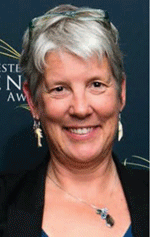Strategies for obtaining ecological data to enhance decommissioning assessments
Sean van Elden A B , Thomas Tothill A and Jessica J. Meeuwig AA School of Biological Sciences, University of Western Australia, Crawley, WA, Australia
B Corresponding author. Email: sean.vanelden@research.uwa.edu.au; svanelden@gmail.com
The APPEA Journal 60(2) 559-562 https://doi.org/10.1071/AJ19235
Accepted: 28 February 2020 Published: 15 May 2020
Abstract
Many offshore oil and gas platforms around the globe are reaching their end-of-life and will require decommissioning in the next few decades. Knowledge on the ecology of offshore platforms and their ecological role within a regional context in Australia is limited and the subsequent consequences of decommissioning remain poorly understood. Remotely operated vehicle (ROV) video is often collected during standard industry operations and may provide insight into the marine life associating with offshore platforms; however, the utility of this video for scientific purposes remains unclear. We propose a standardised method of analysing this large database of archival ROV footage with specific interest in analysing the vertical distribution of fish species. Baited remote underwater video systems (BRUVS) are a widely used tool for studying marine faunal communities, and we demonstrate the value of BRUVS for understanding the regional ecology around offshore platforms. A combination of BRUVS and ROV data can be used to determine the relative ecological value of offshore platforms within a regional context. The Wandoo oil platform on Australia’s North West Shelf was used as a case study to test these proposed methods by assessing demersal and pelagic fish populations both on and around the Wandoo platform and various natural habitats in the region.
Keywords: BRUVS, platform ecology, ROV.

Sean van Elden studied in South Africa where he received his Bachelor of Science (Marine Biology) at the University of KwaZulu-Natal in 2013, and his Bachelor of Science Honours at Nelson Mandela University in 2014. After working at Nelson Mandela University, Sean moved to Australia and joined the Marine Futures laboratory at the University of Western Australia in 2016 as an image analyst. Sean started his PhD in April 2017, investigating the community structure of both benthic and pelagic species associated with offshore platforms, as a basis for future decommissioning decisions |

Thomas Tothill is a recently graduated Master of Biological Sciences student specialising in Marine Biology from the University of Western Australia. As part of his Master’s degree, Thomas undertook a research project analysing the vertical distribution of fish populations on two offshore oil platforms on Australia’s North West Shelf, as part of a collaboration between the University of Western Australia and Vermilion Oil and Gas Australia. Thomas’ area of interest lies in understanding the impacts of various decommissioning scenarios on demersal and pelagic fish population dynamics. |

Professor Jessica Meeuwig is Director of the Marine Futures Laboratory at the University of Western Australia and is a marine ecologist focused on understanding the ecology of reef and open-ocean shark and fish assemblages and the way in which their status reflects anthropogenic impacts and management responses. She has expertise in a diverse repertoire of field and analysis techniques, from BRUVS (and pioneered the development of mid-water systems), to acoustic and satellite tagging, trophic analyses, behavioural studies and predictive modelling. She has previously conducted research with Woodside and Chevron on the North West Shelf. |
References
Ars, F., and Rios, R. (2017). Decommissioning: a call for a new approach. In ‘Offshore Technology Conference, 1-4 May, Houston, Texas, USA.’ Offshore Technology Conference.Bond, T., Langlois, T. J., Partridge, J. C., Birt, M. J., Malseed, B. E., Smith, L., and McLean, D. L. (2018). Diel shifts and habitat associations of fish assemblages on a subsea pipeline. Fisheries Research 206, 220–234.
| Diel shifts and habitat associations of fish assemblages on a subsea pipeline.Crossref | GoogleScholarGoogle Scholar |
Bouchet, P., Meeuwig, J., Huveneers, C., Langlois, T., Lowry, M., Rees, M., Santana-garcon, J., Scott, M., Taylor, M., Thompson, C., and Vigliola, L. (2018). Marine sampling field manual for pelagic stereo-BRUVS (Baited Remote Underwater Videos). In ‘Field Manuals for Marine Sampling to Monitor Australian Waters’. (Eds R. Przeslawski and S. Foster.) pp.105–130. (National Environmental Science Program.)
Cappo, M., Harvey, E. S., and Shortis, M. (2006). Counting and measuring fish with baited video techniques - an overview. In ‘Cutting-edge Technologies in Fish and Fisheries Science. Australian Society for Fish Biology Workshop Proceedings, Hobart, Tasmania, August 2006’. (Eds J. M. Lyle, D. M. Furlani, and C. D. Buxton). pp.101–114. (Australian Society for Fish Biology.)
Claisse, J. T., Pondella, D. J., Love, M., Zahn, L. A., Williams, C. M., Williams, J. P., and Bull, A. S. (2014). Oil platforms off California are among the most productive marine fish habitats globally. Proceedings of the National Academy of Sciences of the United States of America 111, 15462–15467.
| Oil platforms off California are among the most productive marine fish habitats globally.Crossref | GoogleScholarGoogle Scholar |
Driessen, P. K. (1986). Offshore oil platforms: an invaluable ecological resource. Oceans 86, 516–521.
| Offshore oil platforms: an invaluable ecological resource.Crossref | GoogleScholarGoogle Scholar |
Forteath, G., Picken, G., Ralph, R., and Williams, J. (1982). Marine growth studies on the North Sea oil platform Montrose Alpha. Marine Ecology Progress Series 8, 61–68.
| Marine growth studies on the North Sea oil platform Montrose Alpha.Crossref | GoogleScholarGoogle Scholar |
Friedlander, A. M., Ballesteros, E., Fay, M., and Sala, E. (2014). Marine communities on oil platforms in Gabon, West Africa: high biodiversity oases in a low biodiversity environment. PLoS One 9, e103709.
| Marine communities on oil platforms in Gabon, West Africa: high biodiversity oases in a low biodiversity environment.Crossref | GoogleScholarGoogle Scholar |
Gass, S. E., and Roberts, J. M. (2006). The occurrence of the cold-water coral Lophelia pertusa (Scleractinia) on oil and gas platforms in the North Sea: colony growth, recruitment and environmental controls on distribution. Marine Pollution Bulletin 52, 549–559.
| The occurrence of the cold-water coral Lophelia pertusa (Scleractinia) on oil and gas platforms in the North Sea: colony growth, recruitment and environmental controls on distribution.Crossref | GoogleScholarGoogle Scholar |
Langlois, T. J., Williams, J., Monk, J., Bouchet, P. J., Currey, L., Goetze, J., Harasti, D., Huveneers, C., Ierodiaconou, D., Malcolm, H. A., and Whitmore, S. (2018). Marine sampling field manual for benthic stereo BRUVS (baited remote underwater videos). In ‘Field Manuals for Marine Sampling to Monitor Australian Waters’. (Eds R. Przeslawski and S. Foster) pp.82–104. (National Environmental Science Program.)
Letessier, T. B., Juhel, J. B., Vigliola, L., and Meeuwig, J. J. (2015). Low-cost small action cameras in stereo generates accurate underwater measurements of fish. Journal of Experimental Marine Biology and Ecology 466, 120–126.
| Low-cost small action cameras in stereo generates accurate underwater measurements of fish.Crossref | GoogleScholarGoogle Scholar |
Macreadie, P. I., McLean, D. L., Thomson, P. G., Partridge, J. C., Jones, D. O. B., Gates, A. R., Benfield, M. C., Collin, S. P., Booth, D. J., Smith, L. L., Techera, E., Skropeta, D., Horton, T., Pattiaratchi, C., Bond, T., and Fowler, A. M. (2018). Eyes in the sea: unlocking the mysteries of the ocean using industrial, remotely operated vehicles (ROVs). The Science of the Total Environment 634, 1077–1091.
| Eyes in the sea: unlocking the mysteries of the ocean using industrial, remotely operated vehicles (ROVs).Crossref | GoogleScholarGoogle Scholar |
McLean, D. L., Partridge, J. C., Bond, T., Birt, M. J., Bornt, K. R., and Langlois, T. J. (2017). Using industry ROV videos to assess fish associations with subsea pipelines. Continental Shelf Research 141, 76–97.
| Using industry ROV videos to assess fish associations with subsea pipelines.Crossref | GoogleScholarGoogle Scholar |
McLean, D. L., Taylor, M. D., Partridge, J. C., Gibbons, B., Langlois, T. J., Malseed, B. E., Smith, L. D., and Bond, T. (2018a). Fish and habitats on wellhead infrastructure on the north west shelf of Western Australia. Continental Shelf Research 164, 10–27.
| Fish and habitats on wellhead infrastructure on the north west shelf of Western Australia.Crossref | GoogleScholarGoogle Scholar |
McLean, D. L., Macreadie, P., White, D. J., Thomson, P. G., Fowler, A., Gates, A. R., Benfield, M., Horton, T., Skropeta, D., Bond, T., Booth, D. J., Techera, E., Pattiaratchi, C., Collin, S. P., Jones, D. O. B., Smith, L., and Partridge, J. C. (2018b). Understanding the global scientific value of industry ROV data, to quantify marine ecology and guide offshore decommissioning strategies. In ‘Offshore Technology Conference Asia, 20–23 March, Kuala Lumpur, Malaysia.’ Offshore Technology Conference.
McLean, D. L., Taylor, M. D., Giraldo Ospina, A., and Partridge, J. C. (2019). An assessment of fish and marine growth associated with an oil and gas platform jacket using an augmented remotely operated vehicle. Continental Shelf Research 179, 66–84.
| An assessment of fish and marine growth associated with an oil and gas platform jacket using an augmented remotely operated vehicle.Crossref | GoogleScholarGoogle Scholar |
Pradella, N., Fowler, A. M., Booth, D. J., and Macreadie, P. I. (2014). Fish assemblages associated with oil industry structures on the continental shelf of north-western Australia. Journal of Fish Biology 84, 247–255.
| Fish assemblages associated with oil industry structures on the continental shelf of north-western Australia.Crossref | GoogleScholarGoogle Scholar |
Reeds, K. A., Smith, J. A., Suthers, I. M., and Johnston, E. L. (2018). An ecological halo surrounding a large offshore artificial reef: sediments, infauna, and fish foraging. Marine Environmental Research 141, 30–38.
| An ecological halo surrounding a large offshore artificial reef: sediments, infauna, and fish foraging.Crossref | GoogleScholarGoogle Scholar |
Shinn, E. A. (1974). Oil structures as artificial reefs. In ‘Proceedings of an International Conference on Artificial Reefs, Astroworld Hotel, March 20–22, 1974, Houston, Texas’. (Eds L. Colunga and R. B. Stone) pp. 91–96. (Texas A & M University, Center for Marine Resources: College Station, TX, USA.)
Thomson, P. G., Fowler, A. M., Davis, A. R., Pattiaratchi, C. B., and Booth, D. J. (2018). Some old movies become classics – a case study determining the scientific value of ROV inspection footage on a platform on Australia’s North West Shelf. Frontiers in Marine Science 5, 471.
| Some old movies become classics – a case study determining the scientific value of ROV inspection footage on a platform on Australia’s North West Shelf.Crossref | GoogleScholarGoogle Scholar |
van der Stap, T., Coolen, J., and Lindeboom, H. (2016). Marine fouling assemblages on offshore gas platforms in the Southern North Sea: effects of depth and distance from shore on biodiversity. PLoS One 11, e0146324.
| Marine fouling assemblages on offshore gas platforms in the Southern North Sea: effects of depth and distance from shore on biodiversity.Crossref | GoogleScholarGoogle Scholar |
van Elden, S., Meeuwig, J. J., Hobbs, R. J., and Hemmi, J. M. (2019). Offshore oil and gas platforms as novel ecosystems: a global perspective. Frontiers in Marine Science 6, 548.
| Offshore oil and gas platforms as novel ecosystems: a global perspective.Crossref | GoogleScholarGoogle Scholar |


